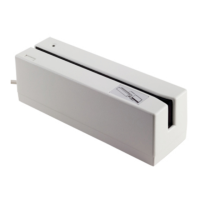P (50H, uppercase) Arm to Read
ACTION The unit performs the following sequence: Clear the read data buffers for all
tracks. Transmit command acknowledge (“^” 5EH). Wait for card swipe. Transmit read
acknowledge (“^” 5EH) after card swipe. After an “Arm to Read” command is received
and acknowledged. The only valid commands that are accepted for execution are:
“Abort” <ESC>, “Warm Reset” <DEL>, “Status” “$”, and LED control commands. All
other commands result in an “Invalid Command” “!” response.
p (70H, lowercase) Arm to Read with speed prompts
ACTION The unit performs the following sequence: Clear the read data buffers for all
tracks. Transmit command acknowledge (“^” 5EH). Wait for card swipe. If Magstripe
®
media is detected a “(" (28H) byte is sent, when media detect goes inactive a “)” (29H)
byte is sent. This is similar to the 'P' command, except an extra response '(' is reported
when a media is detected through the read head. A ')' response is reported when media
detect goes inactive. Mainly used as a tool for determining average swipe speed. Most
applications should not use this command. They should use the upper case P command
instead.
Q (51H) Transmit ISO standard data, track 1
R (52H) Transmit ISO standard data, track 2
S (53H) Transmit ISO standard data, track 3
ACTION The unit performs the following sequence: Process data in the read buffer
for the specified track according to ISO standard. If error is detected in card data,
transmit proper error response ('*' or '+'). Else, transmit data in ASCII.
Note Q, R, and S are special single byte commands for the corresponding cases of
double byte commands, e.g. Q has the same effect as q1.
q (71H) Transmit track 1 data
r (72H) Transmit track 2 data
s (73H) Transmit track 3 data
FORMAT 2-byte command - Command character (q, r, s) is followed by an ASCII
number (1, 2 or 3) representing the ISO track format for processing the Magstripe data.
ACTION The unit performs the following sequence: Process data in the read buffer
for the specified track and format. If no card data errors, transmit data in ASCII.
If error is detected in card data, transmit proper error response ('*' or '+'). These
commands allow a track to be transmitted with a different track’s ISO format. For
example to transmit track 1's data using ISO track 2 format send “q2” (71H, 32H). The
uppercase equivalents (Q, R, and S) are equivalent to q1, r2, and s3.
Note The s1 command decodes track 3 using AAMVA format if the unit is configured for
ISO and AAMVA decoding.

